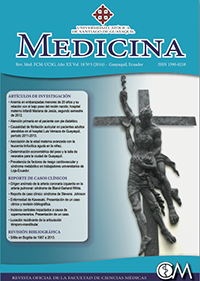Atención primaria en el paciente con pie diabético

Abstract
Objetivo: determinar cuáles son las principales características en el manejo integral del paciente con pie diabético. Materiales y métodos: se realizó un estudio descriptivo, observacional de corte transversal, realizado en el hospital Dr. Abel Gilbert Pontón, desde enero a octubre de 2013. La muestra fue ponderada, por conveniencia, de 156 pacientes diabéticos mayores de 18 años. Resultados: el 72 % de pacientes con riesgo de desarrollar pie diabético no acuden al centro de salud a realizarse controles. Los pacientes que acudían a su centro de salud (28 %), al 64 % el médico no les había examinado los pies en el último año, y un 72 % refirió que nunca recibió algún tipo de charla educativa con respecto al cuidado de sus pies. Conclusiones: se recomienda el desarrollo de un programa de factible aplicabilidad para el médico general y fácil seguimiento para los pacientes que incluya la inspección de miembros inferiores.
Keywords
Pie Diabético, Úlcera del Pie, Prevención de Enfermedades, Atención Primaria de Salud
References
- Análida E. Pinilla, A. L. (2011). Actividades de prevención del pie diabético en pacientes de la consulta externa de primer nivel. Revista de saluid pública, 12.
- Berardis, G. D. (2005). Are Type 2 diabetic patients offered adequate foot care? The role of physician and patient characteristics. Diabetes Complications, 319-327.
- A. Lpsky, B. (2012). 2012 Infectious Diseases Society of America Clinical Practice Guideline for the Diagnosis and Treatment of Diabetic Foot Infectionsa. Oxford: IDSA GUIDELINES.
- International Working Group of the Diabetic Foot. (2011). The development of global consensus guidelines on the management and prevention of the diabetic foot 2011.
- IWGDF. (2012). Time to Act A joint publication of the international diabetes federation and the internation working group on the diabetic foot. Lifescan
- Wrobel, J. S. (2010). Diabetic Foot Biomechanics and Gait Dysfunction. Journal of Diabetes Science and Technology, 833-845.
- DMclnnes, A. (2012). Diabetic foot disease in the United Kingdom: about time to put feet first. Journal of Foot and Anckel Reserch, 5-13.
- O´Relly, D. (2011). a prospective double blind randomize controlle clinical trial comparing standart wound care with adjuntive hiperbaric oxigen therapy for the treatmente of chronic, non healing ulcers of the lower limbin patients with diabetes mellitus. Trials journal, 1-10.
- Nalini Singh, M. (2005). Preventing Foot Ulcers in Patients with Diabetes. Jama Clinician’s Corner.
- NHS. (2011). Diabetic foot problems. Londres: clinical practice at NICE.
- Morales, E. G. (2012). Surgical complications associated with primary closure in patients with diabetic foot. Diabetic Foot & Ankle, 1-7.
- Counting on commitment; the quality of primary care-led diabetes managmente in a sistem with minimal incetives. (2011) . bmc health services research, 1-9.
- Ba, L. (2012). Expert opinion on the management of infections in the diabetic foot. Diabetes Metab, 163-178.
- Sánchez, R. F. (2007). Efectividad de un Programa Educativo basado en el autocuidado de mienbros inferiores para la prevencion de complicaciones. Revista de Facultad de Medicina de Universidad Nacional de Trujillo, 1-73.
- The World Bank. (2010). Burden: mortality, morbidity and risk factors. In Who, Monitoring and surveillance of chronic noncommunicable diseases (pp. 9-31). Ginebra.
How to Cite
Download Citation

This work is licensed under a Creative Commons Attribution 4.0 International License.
